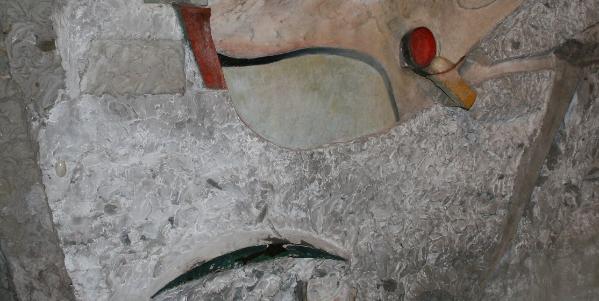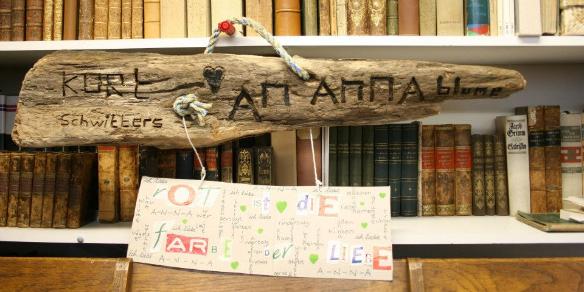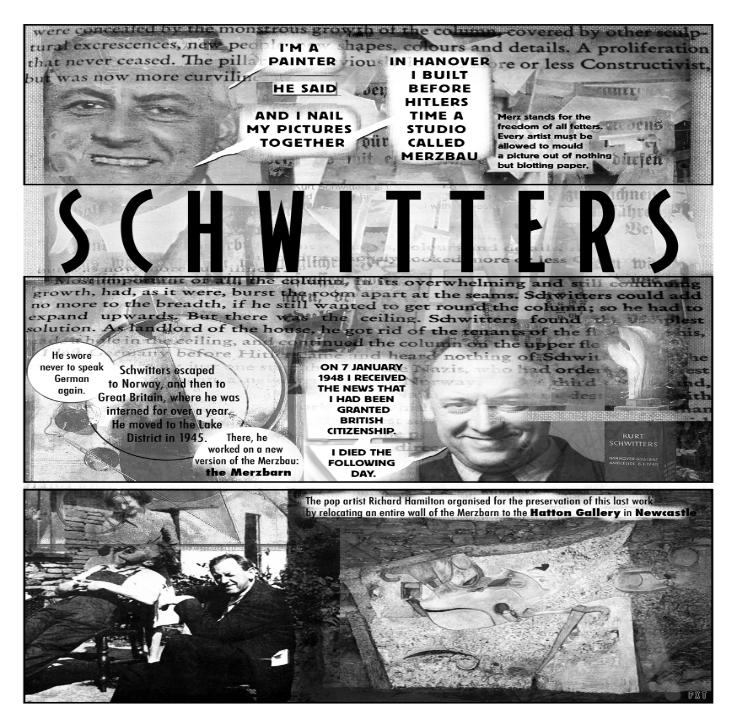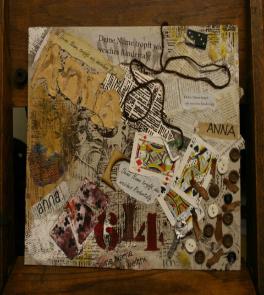Kurt Schwitters
Schwitters: life and career
Born in Hannover, Germany in 1887, Kurt Schwitters had a long and varied career, working in visual art, graphic design, poetry and music. Early in his career Schwitters was affiliated with several avant-garde movements including Der Sturm and Dada. However, much of his art belongs to his own one-man movement, ‘Merz’. His work was included in the Nazis’ mocking ‘Entartete Kunst’ (Degenerate Art) exhibitions of the 1930s.

Merz aimed to close the gap between art and life, using found and discarded everyday materials to create a ‘total work of art’ or Gesamtkuntswerk. The word Merz comes from a fragment of print used in one of his collaged Merzbild or Merz pictures, part of the word Commerzbank (Commerce Bank), it reflected the ability of collage to create new meanings as things are removed from their original context. Schwitters applied the idea of collage to everything he did, including poetry and musical composition. In the case of his constructions or Merzbauten (‘Merz buildings’) he applied it to his entire living environment.
Schwitters worked on four Merzbauten. The original and most extensive Merzbau was constructed in his home in Hannover from 1923. Using found objects and personal items, he constructed a series of nooks and themed grottos across eight rooms. Many of the grottos were designed by or dedicated to other artists. This Merzbau, the ‘Cathedral of Erotic Misery’, was unfinished when Schwitters fled Germany for Norway in 1937. In 1943 it was destroyed by Allied bombing.
Schwitters had often visited Norway, starting work on a second Merz construction in his holiday cottage on the island of Hjertøya in 1932. The relief work on the walls of this structure resembles parts of the Elterwater Merz Barn, parts of it still survive. When he moved to Norway permanently, Schwitters began a third Merzbau in a small wooden hut behind his main home in Lysaker, near Oslo. Fleeing to Britain in 1940, he also left this construction unfinished, fire destroyed it in 1951.
Kurts Schwitters, the Merz Barn and its relation to the North East
Kurt Schwitters and the Merz Barn
The Merz Barn Wall is part of a construction created by German artist Kurt Schwitters (1887-1948) in a Lake District barn in 1947-8. The Merz Barn, like much of Schwitters’ work, was based on the idea of collage, in which found items are incorporated into an art work. Schwitters applied a rough layer of decorator’s plaster and paint over and around these found objects which he placed into spaces in the wall, giving the three dimensional collage an abstract quality. Asked what it meant, he replied ‘all it is, is form and colour, just form and colour’.
Schwitters intended the barn to be a permanent, enveloping 3-dimensional structure, where he could also exhibit existing work. When he died in January 1948 it was left unfinished. Schwitters had previously worked on three similar structures: one in his native Hannover and two more in Norway. Fleeing Germany in 1937, he lived in Norway until the Nazis invaded in 1940. Escaping to Britain, he was interned on the Isle of Man before being released in 1941. After spending time in London, he settled in Ambleside with his companion Edith ‘Wantee’ Thomas. Schwitters died on 8 January 1948, less than six months after beginning work on the Merz Barn. Interrupted for a final time, his ‘life’s work’ remained permanently unfinished.
Schwitters - ‘Yes, I was very ill, I became increasingly thin, but my spirit could not be beaten. I devoted every minute I could to my work. My Merz Barn is better and more important than anything I have done up to now’
 |
Why the Wall is at the Hatton Gallery
In early 1959 the Hatton Gallery hosted an exhibition of Schwitters’ work. After it ended, the art historian and artist Lawrence Gowing, then Professor of Fine Art at the University, reported to the Arts Council of Great Britain that a ‘building in Ambleside, now rapidly disintegrating, which housed a construction by Schwitters, should, he felt, be preserved.’ This set in train a complex chain of events that led to the Merz Barn Wall being permanently installed at the Hatton Gallery.
At first the Arts Council tried to interest the Tate Gallery in saving all or part of the barn. After considerable deliberation and investigation into how to move the main wall, the Tate declined the offer in June 1962. Nearly three more years of discussions about the Merz Barn’s future followed, involving Abbot Hall in Kendal, Newcastle University (then still part of Durham University), Marlborough Gallery in London, the Scottish National Gallery of Modern Art and the barn’s owner, Harry Pierce.
The artist Richard Hamilton, then teaching in Newcastle in the Fine Art Department, helped persuade the University authorities to get involved. Harry Pierce signed a formal Deed of Gift to the University on 26 March 1965 and Hamilton began coordinating a detailed survey of the barn before the Wall was moved.
Fred Brookes, an art student who had helped with Hamilton’s survey, was the University’s nominated representative when the move took place. He also undertook much of the significant conservation and reconstruction work when the Wall was installed in the Hatton in 1966.
Moving the Merzbarn
Once the University had accepted the Wall they had to go about arranging the difficult task of safely moving it from Elterwater to Newcastle. Richard Hamilton first organised a small group of students including Fred Brookes, Mark Lancaster, David and Stuart Wise to undertake a detailed survey of the Wall. Carlisle based company John Laings were awarded the contract to safely detach the Wall from the rest of the building and the University nominated Fred Brookes to oversee their work.
The safe removal of the Wall was a quite incredible feat of engineering. Once it had it had been made into a solid ‘piece’ backed by concrete weighing 25 tons, it had to be cut away from the rest of the existing building, carefully lowered and rolled down the fell side to the waiting Pickfords lorry. Once safely on the lorry it still had to negotiate the narrow Lakeland roads, an overnight stop in Kendal and a two day, 120 mile journey to Newcastle. Stored in a temporary hut while drying out from late September 1965 until the building in which it would be housed was completed, the final risky leg of the wall’s journey was for a crane to hoist it 40 feet high into the air, before lowering it gently into a slot in the roof of its purpose built space on 20 June 1966.
If you would like to to see the Merzbarn Wall for yourself, visit the Hatton Gallery which also features a great number of other interesting pieces of art and exhibitions.
All information on Schwitters and the Merz Barn was kindly provided by the Hatton Gallery.
Schwitters@ Newcastle
Schwitters@ Newcastle is a project run by the German section of Newcastle University's School of Modern Languages from January to May 2013. The project involved several events, such as an art exhibition and Jumble Art, which was an art and German competition involving schools across the North East. Furthermore several workshops with Newcastle University students, based on creative writing on translation in cooperation with the Kurt Schwitters Archive/ Sprengel Museum in Hannover took place.
|
|
 |
The project was co-ordinated by Aletta Rochau, M.A., who was sponsored by a 'Leonardo da Vinci' scholarship and hosted by the German Section at Newcastle University.
For more information, please click here.
Click here for the Schwitters@Newcastle Newsletter.
A Schwitters Cartoon
Paul Thompson, Member of Newcastle University's IT staff designed this creative Schwitters cartoon.
 |
